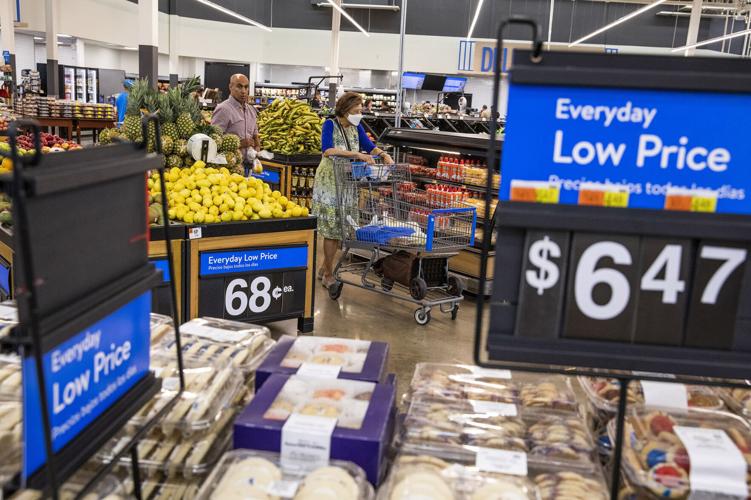Americans are fed up with the price of food, and many are looking to President-elect Donald Trump to lower their grocery bills.
Trump often railed on the campaign trail against hefty price increases for bacon, cereal, crackers and other items.
“We’ll get them down,” he told shoppers during a September visit to a Pennsylvania grocery store.
But the food price inflation that stunned the U.S. and other parts of the world in 2021 and 2022 had complicated causes that are difficult to unwind, from the pandemic to the Ukraine war to avian flu. Many economists think Trump’s plans, including putting tariffs on imported foods and deporting undocumented workers, could actually make food prices increase.

Former President Donald Trump visits Sprankle's Neighborhood Market on Sept. 23 in Kittanning, Pa.
As of October, U.S. prices for food eaten at home were up 28% from 2019, according to government figures released Wednesday. The growth rate peaked in 2022; between October 2023 and October 2024, food prices rose 2%, which was lower than the overall inflation rate.
People are also reading…
Supermarket sticker shock nevertheless weighed on the U.S. electorate. About 7 in 10 voters — including 70% of women and 63% of men — said they were very concerned about the cost of food and groceries, according to AP VoteCast, a survey of more than 120,000 voters. Only 1 in 10 said they were not too concerned or not at all concerned.
Trump won decisively among voters who said they were “very” concerned. About 6 in 10 voters in that group supported him, while 4 in 10 supported Vice President Kamala Harris, his Democratic rival. Harris won strong majorities of voters who were somewhat concerned, not too concerned or not at all concerned.

A customer looks at his mobile phone Sept. 19 while shopping at a grocery store in Chicago.
Asked how he would lower grocery prices during a September town hall in Michigan, Trump said tariffs would help U.S. farmers. Trump called for a 60% tariff on products made in China and a “universal” tariff of 10% to 20% on all other foreign goods that enter the United States. In other speeches, he mentioned even higher percentages.
Trump said U.S. farmers were getting “decimated” because the U.S. allows so many agricultural products into the country. As of 2021, the U.S. imported 60% of its fresh fruit, 38% of its fresh vegetables — excluding potatoes and mushrooms — and 10% of its beef, according to the U.S. Department of Agriculture.
“We’re going to have to be a little bit like other countries,” he said. “We’re not going to allow so much to come. We’re going to let our farmers go to work.”
But David Ortega, a professor of food economics and policy at Michigan State University, said that food producers rely on imported goods like fertilizer, equipment and packaging materials. If they’re forced to pay more for those items, they will raise prices, Ortega said.
U.S. farmers also could have trouble selling their goods overseas, since other countries would likely respond with retaliatory tariffs, he said. Around 20% of U.S. agricultural production is exported each year, according to the USDA.
The Consumer Brands Association, which represents big food companies like Coca-Cola and Nestle as well as personal care companies like Procter & Gamble, says many of its members need ingredients that are grown outside the U.S., like coffee, bananas and chocolate.
“There is a fundamental disconnect between a stated goal of reducing grocery prices and tariff policy that only stands to increase those costs,” said Tom Madrecki, the association’s vice president of campaigns and special projects.
The American Farm Bureau did not respond to a request for comment.

People buy groceries July 11 at a Walmart Superstore in Secaucus, New Jersey.
Ortega said Trump’s plans to deport people who are in the U.S. illegally could also drive up grocery prices. There are more than 2 million undocumented workers throughout the U.S. food chain, he said, including an estimated 1 million working on farms, 750,000 working in restaurants and 200,000 in food production.
At the Michigan town hall, Trump said lowering energy costs by increasing oil and gas drilling would also lower food prices.
“If you make doughnuts, if you make cars, whatever you make, energy is a big deal, and we’re going to get that. It’s my ambition to get your energy bill within 12 months down 50%,” he said.
Energy makes up a relatively small portion of the cost of food production and sales. For every $1 spent on food in 2022, a little less than 4 cents went toward energy costs, according to the USDA. Farm production cost 8 cents, while food processing cost 14 cents.
When asked whether Trump had plans beyond energy and tariffs to lower grocery costs, a spokesperson for his transition team didn’t give further details.
Maria Kalaitzandonakes, an assistant professor of agricultural and consumer economics at the University of Illinois, said her research shows that most voters think politicians can bring down grocery prices.
But Ortega and other economists say there’s very little a president can do, especially in the short term, to lower grocery prices. Sustained price declines typically only happen in steep, protracted recessions.
“People want grocery prices to get down to pre-COVID levels, and that’s just not going to happen,” he said. “Deflation is not something that we want.”
“Lowering food prices is not great,” Kalaitzandonakes said. “What we would want to think about instead is, is your income keeping pace with your bills versus is your bill at the grocery store coming down.”
Trade Wars & the Dinner Table: Which Foods Are Most Vulnerable to Import Tariffs?
Trade Wars & the Dinner Table: Which Foods Are Most Vulnerable to Import Tariffs?

Photo Credit: Studio Concept / Shutterstock
The 2024 presidential race and recent port strikes have brought renewed focus on America’s dependence on foreign goods and U.S. trade policy more broadly. Both President Trump and Vice President Harris have signaled a shift away from long-standing support for free trade, though their approaches differ. President Trump has proposed blanket tariffs of up to 20% on all imports, with even higher rates on goods from China. Vice President Harris’s policies are less defined, but indicate potential tariff adjustments to address economic and labor concerns.
Though views on protectionist policies vary, there is general agreement that tariffs could have immediate effects on U.S. consumers, particularly when it comes to prices. Similarly, experts warned that American households would likely have experienced shortages and higher retail prices had the dockworkers strike dragged on. With inflation already straining household budgets, additional tariffs and shortages of imported goods could drive up the cost of everyday necessities, including the cost of food.
Currently, the U.S. imports nearly a fifth of its food supply from abroad, and the average American household spends nearly 14% of its annual budget on food and beverages. For many, this is already a burden—28% of U.S. adults report difficulty affording food, and 13.5% of households are classified as food insecure, meaning they lack reliable access to sufficient nutrition.
To better understand the potential impact of import tariffs and foreign good shortages on the U.S. food supply, researchers at Trace One, a company specializing in regulatory compliance for the food and beverage industry, analyzed the most recent data from the USDA, U.S. Census Bureau, and U.S. Bureau of Economic Analysis. Their focus was on tracking changes in food imports over time, examining food imports as a percentage of total consumption, identifying key trade partners, and highlighting the top imports for each state. For more information on the data sources and methodology, refer to the methodology section.
U.S. Agricultural Imports & Exports

USDA forecasts $42B agricultural trade deficit in 2025
Trace One analysis of USDA data
The U.S. has traditionally exported more agricultural goods than it imported, but this balance has shifted in recent years as import growth has outpaced exports. Demand for imported goods has surged, driven by factors such as a strong U.S. dollar and consumer preferences for year-round access to fresh produce.
Looking ahead, the USDA forecasts a $42 billion agricultural trade deficit in 2025, which would be the largest on record in at least the past three decades. U.S. agricultural exports are expected to decline to $169.5 billion, a $4 billion drop from the previous year, due to falling prices for key commodities like soybeans, corn, and cotton, as well as reduced beef exports. Meanwhile, agricultural imports are projected to rise to $212 billion, driven by increasing demand for produce and sugar.
Imports as a Share of Consumption by Food Category

Nearly 60% of fruits & nuts consumed in the U.S. are imported
Trace One analysis of USDA data
Imported foods have become an increasingly significant part of the American diet, with the share of imported goods rising across nearly every food category in recent years. Between 2008 and 2022, the percentage of total food and beverages consumed in the U.S. that were imported increased from 12.4% to 17.3%. However, this growing reliance on imported food has been particularly pronounced in certain categories.
Fruits and nuts stand out as one of the most import-dependent categories, with nearly 60% of the fruits and nuts consumed in the U.S. now coming from abroad, up from 35.8% in 2008. Similarly, imports of milled grains and oils have grown sharply, now accounting for 57.4% of consumption, compared to 31.5% in 2008. Other categories like sweeteners and vegetables have also seen notable increases, with imports now constituting 45.0% and 40.4% of consumption, respectively.
In addition to these categories, the U.S. is heavily reliant on imports for seafood, with an estimated 70–85% of seafood consumed domestically coming from international sources. As tariffs and trade policies potentially shift, these high levels of dependency on imported goods could have a direct impact on food prices at the consumer level.
Top Trade Partners & Imports

Food & beverage imports from Mexico & Canada account for 42% of the U.S. total
Trace One analysis of U.S. Census Bureau data
At the country level, Mexico and Canada account for 42% of total U.S. food and beverage imports. Mexico exported over $44 billion in food products to the U.S. in 2023, primarily beer, while Canada exported $38 billion, with bread and pastries as its leading category. Italy and France are among the top European exporters, with wine as their primary export to the U.S. Other significant trade partners include Chile, which supplies salmon, and Brazil, a major source of coffee.
China, India, and Indonesia are key contributors from Asia, exporting a variety of products such as oils and shrimp. Australia and New Zealand are important suppliers of beef, while countries like Peru and Vietnam export grapes and cashews, respectively.
Among specific food categories, bread and pastries are the largest import, valued at nearly $6.9 billion. Prepared foods, coffee, and frozen shrimp also rank high in value, while beer leads among beverages, followed by liqueurs, cordials, and wine.
The Top Food & Beverage Import in Every State

The top food and beverage imports by state vary greatly, spanning everything from cooking oils and prepared foods to meats, seafood, fresh produce, and alcohol. Prepared foods, canola oil, and beef each claim the top spot in five states. Coffee ranks as the leading import in four states, while bread and pastries dominate in three. Interestingly, despite beer being the top food and beverage import nationally, Illinois is the only state where it ranks as the number one state-level import.
Methodology

Photo Credit: Studio Concept / Shutterstock
The data used in this study comes from the USDA’s Economic Research Service, U.S. Census Bureau's USA Trade Online, U.S. Census Bureau’s Household Pulse Survey, and U.S. Bureau of Economic Analysis’s Consumer Spending by State.
The top food and beverage import commodities for the U.S. overall, by country, and by state were determined as those with the greatest import value in 2023 based on six-digit Harmonized System (HS) commodity codes. Where applicable, commodity descriptions were updated to improve readability. The following HS commodity categories were included: 02; 03; 04; 07; 08; 09; 10; 11; 12; 13; 15; 16; 17; 18; 19; 20; 21; 22.
The percentage of adults experiencing food affordability challenges was sourced from the Household Pulse Survey Phase 4.2 Cycle 09. This figure represents the proportion of respondents who reported being unable to afford more food. State-level data on food insecurity covers the period from 2021 to 2023, while national-level data reflects conditions in 2023 alone.
For complete results, see Trade Wars & the Dinner Table: Which Foods Are Most Vulnerable to Import Tariffs? on Trace One.

















